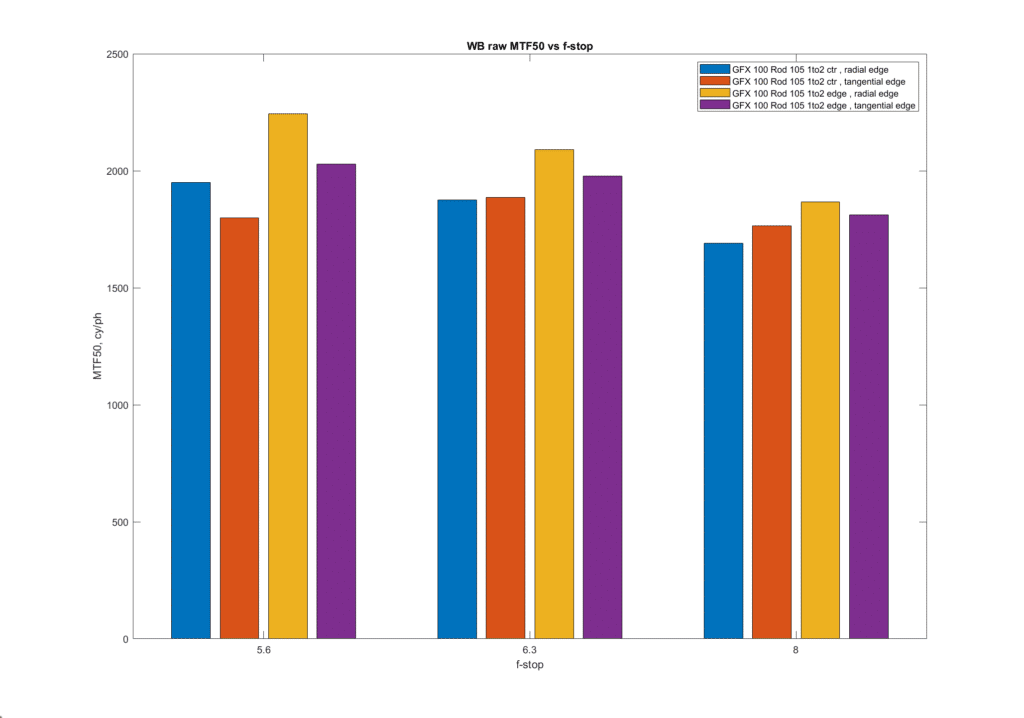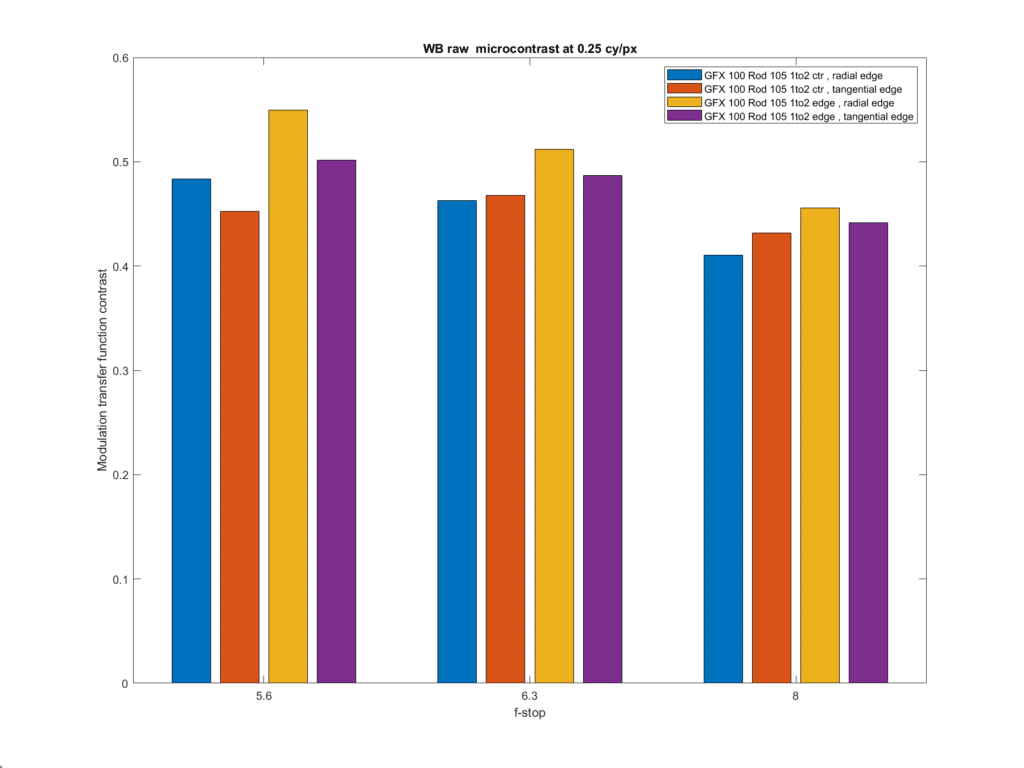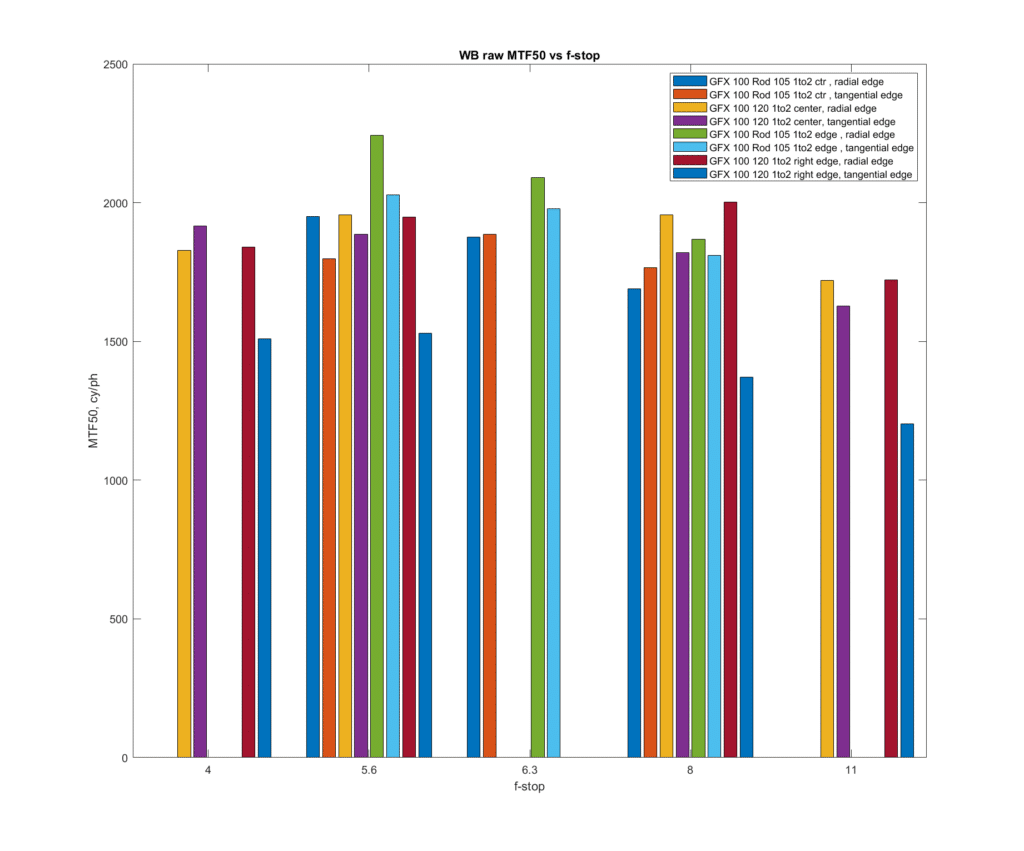This is one in a series of posts on the Fujifilm GFX 100S. You should be able to find all the posts about that camera in the Category List on the right sidebar, below the Articles widget. There’s a drop-down menu there that you can use to get to all the posts in this series; just look for “GFX 100S”. Since it’s more about the lenses than the camera, I’m also tagging it with the other Fuji GFX tags.
In the previous post, I showed you MTF curves for the Rodenstock 105/5.6 HR Digaron Macro on GFX 100S at 1:1. Now I’ll show you the results of testing the same lens at 1:2 magnification, which is close to the magnification that you’d used for digitizing 6×6 or 6×7 negatives.
Here’s the test procedure:
- GFX 100S
- Foba camera stand
- C1 head
- Lens focused to get to 1:2 magnification
- ISO 100
- Electronic shutter
- Indicated f/5.6 through f/8 in half-stop steps
- Exposure time adjusted in M mode
- Cognisys rail, 100 exposures, 80 um step size
- Initial focus short of target
- Convert RAF to DNG using Adobe DNG Converter
- Extract raw mosaics with dcraw
- Extract slanted edge for each raw plane in a Matlab program the Jack Hogan originally wrote, and that I’ve been modifying for years.
- Analyze the slanted edges and produce MTF curves using MTF Mapper (great program; thanks, Frans)
- Fit curves to the MTF Mapper MTF50 values in Matlab
- Correct for systematic GFX focus bracketing inconsistencies
- Analyze and graph in Matlab
Here are the results:
The vertical axis is MTF50 in cycles per picture height. Higher is sharper. The horizontal axis is f-stop.
- The blue and red columns are for the lens on axis, with, respectively, a horizontal and a vertical edge.
- The yellow and purple columns are for the lens at the far right edge, with, respectively, a horizontal and a vertical edge.
These are excellent.
Here is the microcontrast, which for this test I’m defining as the contrast at 1/4 the pixel pitch.
Also excellent.
Here’s how the Rodenstock lens compares with the Fuji 120 mm f/4 GF macro:
The Rodenstock lens is a better performer off axis, but the Fuji results are quite credible. Because of internal focusing, the Fuji is faster when they’re both set to f/5.6 and f/8, which reduces diffraction and boosts the results on axis.



Hello Jim,
Is the Rodenstock 105mm Digaron 5.6 Macro Lens the same lens as the Rodenstock/ALPA Macro Switar 105mm 5.6 Macro Lens? I realize that Rodenstock makes the ALPA.
My camera is a FujiFilm GFX100S. Everything is set up on Novoflex Castel-Micro Motorized Slide and equipment. All of that sits on top of RRS’s largest ball head and slide, and Gitzo’s largest Systematic tripod. I have found that Canon’s EX 26 Macro flash with 6 passive reflectors works consistently.
I then stack through Helicon. My biggest problem is edge halo. I am in need of a more advanced Additive software. I understand that “Smart Edge” is somewhere in beta, but I can’t find it. I know it’s not Adobe’s.
All I am photographing this year are segments of flowers and grasses, in studio. I am in search of as close to corner to corner perfection as I can reach (minimum 12′ x 12′ print), at 1′ viewing. I can get close to 8′ x 8′ now with my 5D Mark IV and the Canon 100 macro, and a little cleaning. My feeling is that the Rodenstock combined with my new GFX100S and Helicon will approach my goal.
Thanks,
Greg
It is indeed.
Do you have the capability of moving just the sensor, and leaving the lens in the same position throughout the series of captures?
Thanks for such a quick response Jim!
I always do with the Novoflex Castbal-Pro Bellows which is on top of the Castel-Micro Motorized Slide. The problem usually takes place when there is a lighter part of the flower or grass over a darker part. I’ve tried all different kinds of soft lighting with soft boxes. Nothing works as well as calibrated macro flashes and multiple passive reflectors. What I’d love to have is a number of 12″ passive reflectors, each with a 100+ tiny multi-angled reflectors on them. The more passive reflectors I use and the more stacked shots I shoot the less the edge halo shows up. The grass is even worse.
Sorry in advance, but the colors in your charts are too close to each other. If it’s 2 lenses I can kind of get it, but if it’s more than two it’s impossible to tell which is which. Sorry for nitpicking.
Noted. Do you have a color vision deficiency?